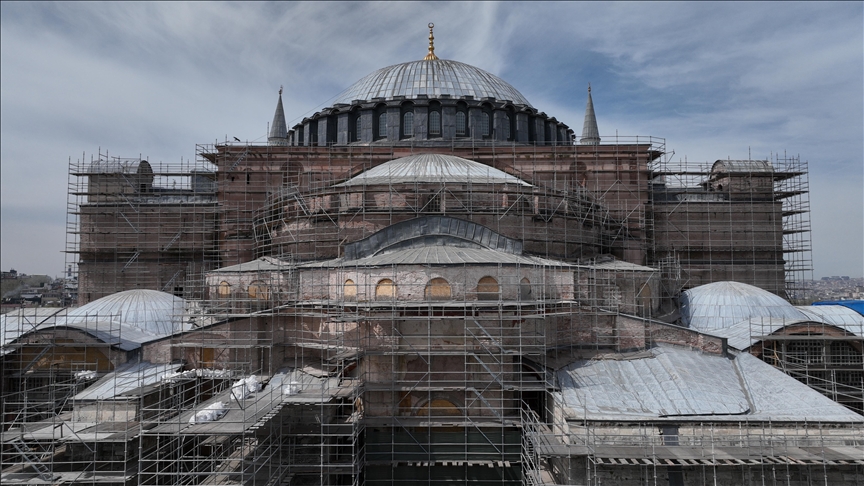Hagia Sophia: How Türkiye is protecting ŌĆśheart of IstanbulŌĆ� from quake threat
IstanbulŌĆÖs famed Hagia Sophia is undergoing its most extensive restoration in over a century to address seismic threats
 A view of the 1486-year-old Hagia Sophia Grand Mosque, undergoing the largest and most comprehensive restoration process in history, in Istanbul, Turkiye on April 14, 2025.
A view of the 1486-year-old Hagia Sophia Grand Mosque, undergoing the largest and most comprehensive restoration process in history, in Istanbul, Turkiye on April 14, 2025.
- ‘Our goal is to intervene using the most appropriate methods for its current state and extend its lifespan,’ explains architect Hasan Firat Diker
- Experts emphasize importance of steps to protect Istanbul’s trove of cultural and heritage sites
ISTANBUL
For nearly 1,500 years, the Hagia Sophia has stood tall over Istanbul, weathering empires, earthquakes and time itself. But as the threat of another major quake looms, vulnerabilities in its aging structure have surfaced, and efforts are afoot to protect the iconic landmark.
“Hagia Sophia can be seen like a patient, with more health problems appearing as time goes on,” architect Hasan Firat Diker told Anadolu.
Now, working with the diligence of a doctor, Diker is part of the Hagia Sophia Scientific Committee, a team undertaking the building’s most extensive rehabilitation in a century.
The Hagia Sophia was built in the 6th century, and its dome – among the first built on pendentives – collapsed in 558, and partially again in 989 and 1346.
Since then, the structure and dome have held firm, even as other buildings around it fell in the quakes of 1509, 1526, 1766 and 1894.
“Hagia Sophia is the heart of Istanbul,” said Diker, a professor of architecture at the Fatih Sultan Mehmet Vakif University in the Turkish megacity.
“Its continued preservation can be attributed to the efforts of every ruling power – from the Byzantines to the Ottomans and into the Turkish Republic era – each doing their best within their economic means to protect it.”
‘Protect it, not alienate it’
The Hagia Sophia, a cathedral, museum and mosque at different points in time, is now undergoing its most extensive restoration since the founding of the Turkish Republic in 1923.
Initial work focused on surrounding Ottoman-era structures, but attention has now turned to the main building.
“We know its most vulnerable points. Our reinforcement efforts will proceed accordingly,” said Diker.
One of the biggest issues lies in the four asymmetrical arches supporting the main dome – a result of earlier repairs and historic damage.
“Especially after the last two major collapses during the Byzantine era, the dome and arches had to be rebuilt. But they were made thinner than they should have been, which made the structure more fragile and in constant need of protection,” he explained.
One major threat during earthquakes is hammering – a phenomenon where two adjacent buildings or structural components collide with each other due to insufficient separation between them.
“During an earthquake, the two semi-domes, which were built to support the main dome, can start to sway. This movement may create hammering, which risks damaging the main dome instead of protecting it,” he said.
Engineers are now reinforcing connection points between the main dome and semi-domes to reduce this danger.
“Even though Hagia Sophia has structural weaknesses, we’re not in a position to rebuild it from scratch. Instead, our goal is to intervene using the most appropriate methods for its current state and extend its lifespan,” he added.
The restoration includes cleaning the underground sections, restoring the dome and minarets and addressing long-standing structural vulnerabilities.
“In previous restorations, especially when Hagia Sophia was a museum, scaffolding around the whole building was often avoided to preserve the visitor experience,” he said. “Now, we’re taking a more holistic approach.”
Every phase of the project is being shaped by disaster scenarios, including a high-magnitude earthquake, he said.
“These earthquake simulations aren’t new – engineers have been studying this since the 1999 earthquake,” he said, adding that today, with advanced technology and data from major global quakes, they are able to model much more realistic interventions.
He emphasized that the project avoids unnecessary intervention that might compromise the building’s character.
“We want to protect it, but we don’t want to alienate it,” he said.
Systematic review of quake resilience
Ilknur Turkoglu, a cultural heritage expert, said Istanbul’s seismic risk is well established.
“Though Istanbul does not sit directly on a major fault line, its surrounding region is highly active, causing significant earthquakes that have historically caused damage to the city, like the 1999 Golcuk and Duzce earthquakes,” Turkoglu said.
“With such a large and dense population, the damage and casualties from a similar earthquake today would be far greater,” she warned.
Istanbul’s cultural wealth – as the capital of the Roman, Byzantine and Ottoman empires – adds another layer of risk. Many structures are centuries old and vulnerable.
“Knowing exactly what we have is the first step,” said Turkoglu, an assistant professor at the Istanbul Gelisim University’s Department of Architecture.
“Unfortunately, Istanbul still lacks a comprehensive inventory of its cultural assets, both above and below ground.”
She called for a systematic review of the earthquake resilience of such sites, and for immediate reinforcement where risks are identified.
Museums housed in historic structures also need urgent planning.
“We need to conduct earthquake drills, ensure artifacts and display cases are secure, and check that emergency systems like automatic shutoffs for electricity, gas and water are in place,” she said.
Even if walls remain standing, she added, unsecured objects inside can still injure or kill.
The situation following the 1999 and February 2023 earthquakes offered a preview, she said, of what could happen without better preparedness, including plans to protect or relocate valuable artifacts.ŌĆŗŌĆŗŌĆŗŌĆŗŌĆŗŌĆŗŌĆ�
Anadolu Agency website contains only a portion of the news stories offered to subscribers in the AA News Broadcasting System (HAS), and in summarized form. Please contact us for subscription options.







